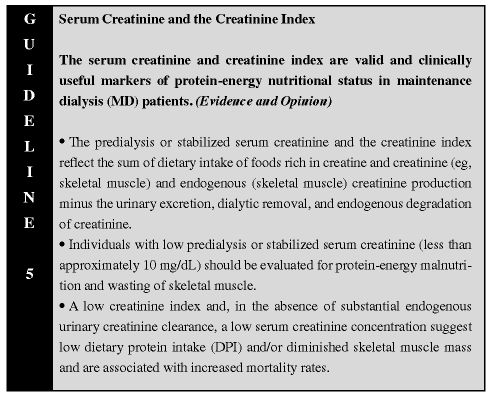
1. Evaluation of Protein-Energy Nutritional Status

In MHD patients with little or no renal function who are receiving a constant dose of dialysis, the predialysis serum creatinine level will be proportional to dietary protein (muscle) intake and the somatic (skeletal muscle) mass.17,45,46 In chronic peritoneal dialysis (CPD) patients with little or no residual renal function, the stabilized serum creatinine level with a given dialysis dose will be proportional to skeletal muscle mass and dietary muscle intake. Thus, a low predialysis or stabilized serum creatinine level in an MD patient with negligible renal function suggests decreased skeletal muscle mass and/or a low dietary protein intake (DPI).17 Among nonanuric individuals, this relationship persists, but the magnitude of the urinary creatinine excretion must be considered when interpreting the predialysis or stabilized serum creatinine as a nutritional parameter. This is particularly relevant to CPD patients, who are more likely to maintain residual renal function for longer periods.
The creatinine index is used to assess creatinine production and, therefore, dietary skeletal muscle protein intake and muscle mass. The creatinine index estimates fat-free body mass rather accurately in individuals with ESRD.46,48 Appendix II discusses creatinine metabolism in greater detail and describes methods for calculating the creatinine index and, from this value, the fat-free body mass.
In individuals in whom loss of skeletal muscle mass is suspected on the basis of low or declining serum creatinine levels, this observation may be confirmed using the creatinine index. Direct relationships between serum creatinine and the serum albumin29,33,42a and prealbumin concentrations42a are reported. Among individuals undergoing CPD, the creatinine index is lower in individuals with protein-energy malnutrition as determined by a composite nutritional index.30
Serum creatinine and the creatinine index are predictors of clinical outcome. In individuals undergoing maintenance HD (MHD), predialysis serum creatinine14,25,42,44,45,49-52 and the molar ratio of serum urea to creatinine are both predictive of and inversely related to survival. This relationship persists even after adjusting for patient characteristics (age, sex, diagnosis, and diabetic status) and dialytic variables.14,25,44,45,50,52 The serum creatinine at the onset of MHD distinguishes between short-term (< 12 months) and long-term (> 48 months) survival in incident patients.25 In longitudinal studies of PD patients, initial serum creatinine levels are inversely related to mortality.25,44,52 The creatinine index is directly related to the normalized protein equivalent of total nitrogen appearance (nPNA) and independent of the dialysis dose (Kt/Vurea).53 A low or declining creatinine index correlates with mortality independently of the cause of death, although people with catabolic diseases may have larger and faster declines in the creatinine index before death.53 Some research has not shown a clear association between the serum creatinine concentration and outcome.23,42,54
The serum creatinine concentration that indicates malnutrition has not been well defined. The mortality risk associated with low serum creatinine increases at levels below 9 to 11 mg/dL in individuals on MHD or PD.14,25,30,44,51 In individuals with negligible urinary creatinine clearance (CrCl), the nutritional status of individuals undergoing MHD or CPD who have a predialysis or stabilized serum creatinine of less than approximately 10 mg/dL should be evaluated.